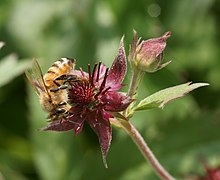Comarum palustre
| Comarum palustre | |
|---|---|

| |
| Scientific classification | |
| Kingdom: | |
| (unranked): | |
| (unranked): | |
| (unranked): | |
| Order: | |
| Family: | |
| Genus: | |
| Species: | C. palustre
|
| Binomial name | |
| Comarum palustre | |
| Synonyms | |
|
Potentilla palustris (L.) Scop. | |
Comarum palustre (syn. Potentilla palustris), known by the common names purple marshlocks, swamp cinquefoil and marsh cinquefoil,[1] is a common waterside shrub. It has a circumboreal distribution, occurring throughout North America, Europe, and Asia, particularly the northern regions. It is most commonly found on lake shores, marshy riversides and stream margins, often partly submerged with foliage floating. It is a parent of some Fragaria–Comarum hybrids, ornamental plants produced by crossing with strawberries.
Description
Its branches spread into leaves with three to seven narrow leaflets which are sharply jagged. The stem is a reddish-brown, low sprawling, vine-like structure. Flowers extend from the branch which vary from red to purple, and are about one inch in diameter, blooming in summer. The stems roots at the base then rises to about 30 cm (12 in).[2]
Cultivation
Swamp cinquefoil prefers peat soils but can also grow in moist sandy areas. It flourishes in USDA Zone 3 (minimum −40 °F or −40 °C). It grows to about 12–18 in (30–46 cm) wide by 12–18 in (30–46 cm) high when cultivated properly.
References
- ^ "BSBI List 2007". Botanical Society of Britain and Ireland. Archived from the original (xls) on 2015-01-25. Retrieved 2014-10-17.
{{cite web}}: Unknown parameter|deadurl=ignored (|url-status=suggested) (help) - ^ Parnell, J. and Curtis, T. 2012. Webb's An Irish Flora. Cork University Press.ISBN 978-185918-4783
External links
- Jepson Manual Treatment
- USDA, NRCS (n.d.). "Comarum palustre". The PLANTS Database (plants.usda.gov). Greensboro, North Carolina: National Plant Data Team.
- "Comarum palustre". Germplasm Resources Information Network. Agricultural Research Service, United States Department of Agriculture.
- Washington Burke Museum
- Comarum palustre in the CalPhotos photo database, University of California, Berkeley
- Wildflower.org.uk description
